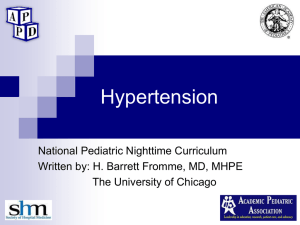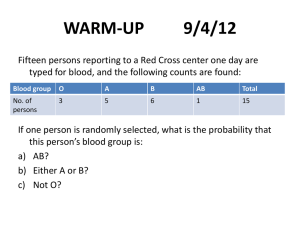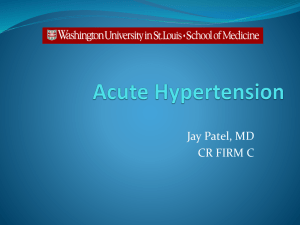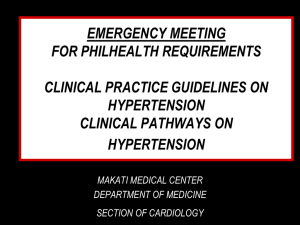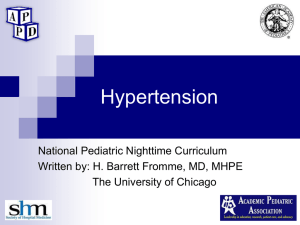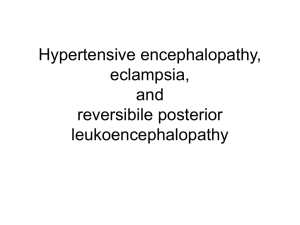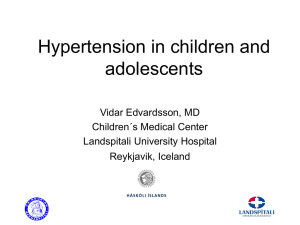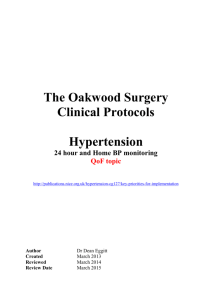Hypertensive Urgency/Emergency Module#11
advertisement
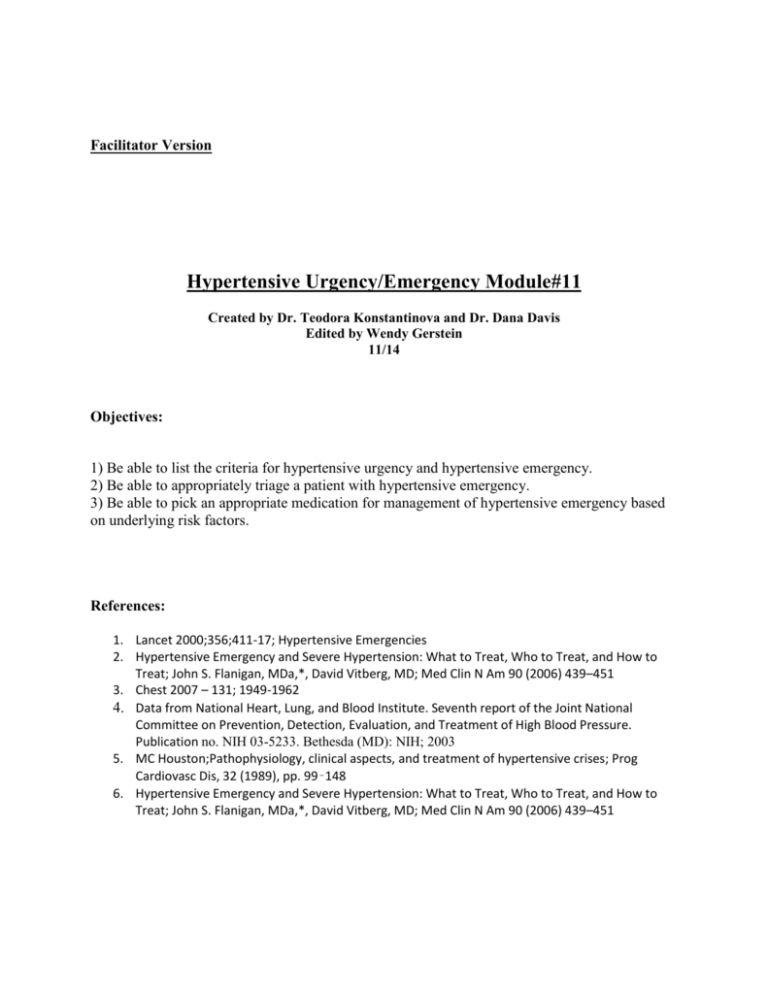
Facilitator Version Hypertensive Urgency/Emergency Module#11 Created by Dr. Teodora Konstantinova and Dr. Dana Davis Edited by Wendy Gerstein 11/14 Objectives: 1) Be able to list the criteria for hypertensive urgency and hypertensive emergency. 2) Be able to appropriately triage a patient with hypertensive emergency. 3) Be able to pick an appropriate medication for management of hypertensive emergency based on underlying risk factors. References: 1. Lancet 2000;356;411-17; Hypertensive Emergencies 2. Hypertensive Emergency and Severe Hypertension: What to Treat, Who to Treat, and How to Treat; John S. Flanigan, MDa,*, David Vitberg, MD; Med Clin N Am 90 (2006) 439–451 3. Chest 2007 – 131; 1949-1962 4. Data from National Heart, Lung, and Blood Institute. Seventh report of the Joint National Committee on Prevention, Detection, Evaluation, and Treatment of High Blood Pressure. Publication no. NIH 03-5233. Bethesda (MD): NIH; 2003 5. MC Houston;Pathophysiology, clinical aspects, and treatment of hypertensive crises; Prog Cardiovasc Dis, 32 (1989), pp. 99–148 6. Hypertensive Emergency and Severe Hypertension: What to Treat, Who to Treat, and How to Treat; John S. Flanigan, MDa,*, David Vitberg, MD; Med Clin N Am 90 (2006) 439–451 Case 55 yo male with history of hypertension and high cholesterol presents to the ED with complaints of a severe bi-frontal headache for the last 3 days, getting progressively worse. He noted blurred vision, and feels like he is in a fog. He also reports that in the last few days he felt very tired and SOB and noticed swelling of his lower extremities. His medications are Lipitor and Norvasc, which he has been taking regularly. He is a non-smoker, denies alcohol or drug use. Exam: BMI=37; bp is 250/140 in both arms, pulse 98, afebrile with RR 24, 88% on RA. He is uncomfortable, fundi with papilledema, JVP is 11 cm, lungs have bibasilar crackles, CV with s2,s2 and s4. Extremities with normal pulses and 1+ edema at ankles. Normal neurological exam. What is your clinical assessment of this patient’s presentation and give one reason to support your assessment. Patient is presenting with hypertensive emergency. He has evidence of end-organ damage: decompensated heart failure and possible hypertensive encephalopathy (papilledema, blurred vision, and foggy feeling). What would be your next step? You need to complete your assessment looking for other evidence of end-organ damage and start appropriate therapy. First step would be to obtain an EKG, CXR and non-contrasted head CT looking for acute changes (what would you be looking for in each study?), and you also need basic labs, with particular focus on renal function. You should also calculate his MAP [MAP = DP + 1/3 (SP-DP)]. Additional data on patient: EKG: sinus rhythm, no acute changes in ST segments, no Q waves. CXR: bilateral interstitial markings, fluid in the fissure. Head CT without contrast: negative for bleed or edema or other signs of increased intracranial pressure. Labs: wbc: 10, H/H: 14/42, plt: 150; Na 136, K 4.0, Cl 109, CO2 23, BUN/creat: 24/1.8, glucose-129; Pro-BNP = 8,560; troponin is negative. UA: 0 rbc, 0 wbc, trace protein. MAP= 140+1/3 (250-140) = 176mm Hg Should his BP be lowered immediately? Yes. Lower MAP by 10 to 20% over 1 hour (so target MAP would be 142-159). Then aim to lower MAP by 5-15% more over the next 23 hours. What is the appropriate unit for this patient? All patients with hypertensive emergencies must be managed in the ICU with IV medications. Transiently lowering the BP does not constitute treatment of hypertensive emergency. The patient should be observed to be stable over time – generally 24 to 48 hours – prior to transitioning to less predictable treatment (i.e. oral medications) so as to avoid precipitating further malperfusion (6). What would be an appropriate medication to use in this patient and why? Due to the signs of decompensated heart failure (oxygen requirement, crackles, elevated JVP, LE edema) the drug of choice to start with would be a loop diuretic. An easily titratable vasodilator (eg, sodium nitroprusside, nitroglycerin) can be added to reduce afterload. Drugs that increase cardiac work (hydralazine) or acutely decrease cardiac contractility (labetalol or other beta blocker) should be avoided during the initial management. The goal of therapies is treatment of heart failure and improvement in pulmonary edema, which can often be achieved with a 10 to 15 percent reduction in blood pressure. Case continues: The patient’s blood pressure improves gradually with diuresis and patient clinically improves. After 48 hours he is euvolemic on exam and is no longer requiring oxygen. His echocardiogram shows LVH with evidence of impaired diastolic relaxation. His creatinine comes down to 1.3 with normal potassium. His BP is now 180/70. What would be a good oral regimen for BP control at this point? Two good possible regimens: 1) ACE I (or ARB) plus low dose thiazide diuretic 2) Beta blocker plus low dose thiazide diuretic Do you need to do any further workup of his hypertension? Secondary causes of hypertension are more common in patients who have a hypertensive emergency compared with other hypertensive populations. Thus, patients with a hypertensive emergency should be evaluated for common forms of secondary hypertension. Based on his presenting exam, what is a possible secondary cause of his hypertension? BMI=37 need to consider OSA and refer patient for sleep study. He also may be developing hypertensive renal disease and will need close monitoring of his creatinine, particularly with diuretic and/or ACEI use. Patient also needs to be counselled on weight loss, and screened for diabetes. If patient had presented with similar BP readings but was asymptomatic with normal labs and studies, how would your management differ? Patient would then be classified with hypertensive urgency. Hypertensive urgency does not require rapid lowering of blood pressure with IV medication but treatment should be initiated immediately in this patient with an oral agent. Rapid lowering of blood pressure should be avoided. (3). Recommended intervention and follow up for asymptomatic patients without evidence of end organ damage (4): BP (mm Hg) 140–159/90–99 160–179/100–109 180–209/110–119 210/120 Follow up Observe and confirm within 2 months Confirm and treat within 1 month Confirm and treat within 1 week Confirm, evaluate, and initiate therapy immediately with close follow up. Though there is no clear consensus, nor evidence that rapidly lowering BP in asymptomatic patients with severe hypertension improves outcomes, JNC 7 allows that some experts recommend treating these patients with short acting antihypertensives (preferably medications the patient had missed if that is the case), observing them for several hours, and arranging for follow-up within “several days.” Epistaxis, anxiety, and headache do not qualify as evidence of end organ damage. Hypertensive urgency alone is not an indication for admission nor for prolonging hospitalization, but comorbid conditions (e.g. known aneurysm, LV dysfunction, inability to take oral medications, lack of appropriate follow-up) must be taken into account when determining disposition. How would you document the patient's primary diagnosis under ICD9? ICD 10? ICD9 – Hypertensive emergency. Severe hypertension with suspected pulmonary edema and AKI. ICD10 – Hypertensive emergency due to uncontrolled essential hypertension associated with pulmonary edema and acute kidney injury. MKSAP Nephrology questions: Question 1. Manage newly diagnosed stage 2 hypertension. Answer A. Question 12. Diagnose resistant hypertension. Answer A. Question 29. Manage hypertension in a diabetic. Answer A. Question 33. Evaluate a patient with hypertension. Answer B. Question 43. Manage renovascular hypertension. Answer C. Question 103. Diagnose underlying CKD and hypertension in a pregnant patient. Answer A. Appendix 1. Classification of Hypertension (JNC 6) Stage I Stage 2 Stage 3 140-159 160-179 >179 Definitions: (JNC7) Severe Hypertension: Secondary Hypertension: Hypertensive emergency: Hypertensive urgency: Hypertensive crisis: Reactive hypertension: Accelerated hypertension: Malignant hypertension: 90-99 100-109 >109 (no longer included in JNC 7, now called “severe HTN) BP > 179/109 which is confirmed on at least 2 measurements at least 5 minutes apart. Hypertension resulting from an underlying, identifiable, often correctable cause. Evidence of, or impending, end organ damage associated with marked elevations in BP – most commonly severe hypertension. Severe hypertension with no evidence of end organ damage. Catchall phrase which encompasses hypertensive emergency and hypertensive urgency. Acute hypertension which is secondary to a temporary stimulus such as hypoxia, stress, anxiety, pain, volume overload, or bladder distension. Severe hypertension with the presence of retinal flame hemorrhages or exudates - generally with evidence of end organ damage. Severe hypertension with papilledema and either (most commonly) encephalopathy or nephropathy. Documentation pearls: ICD 9: Document “Accelerated” or “Malignant” HTN (if present) otherwise Severe HTN, Hypertensive crisis, or Hypertensive Urgency. If Hypertensive Emergency, document this as well as the end organ damage present (e.g. “hypertensive emergency with hypertensive encephalopathy”.) ICD 10: Document Diagnosis (essential/secondary HTN), severity (urgency/emergency/ malignant), Chronicity (acute/chronic), Related problems (end organ damage identified/symptoms suggesting impending end organ damage) Appendix 2. Special situations: Acute Postoperative Hypertension (APH) Poorly defined entity – typically identified as a significant elevation in BP during the immediate postoperative period which may lead to serious complications. Arbitrarily some authors give parameters of BP > 190/100. It usually begins within 2 hours of surgery and resolves within 4 to 6 hours. The first step is to evaluate patient for causes of secondary or reactive hypertension and treat those if present. Only in patients who have had cardiovascular surgery has it been shown that aggressive BP control improves outcomes (7) After cardiovascular surgery the recommendation is to keep BP <140/90. All other episodes of APH are evaluated for urgency of treatment on a case-by-case basis. Most expert opinion (unsupported) favors initiating aggressive therapy once BP reaches some threshold (based on preferences of anesthesia and surgeons). Most commonly recommended medications: Nitroprusside, NTG, labetolol, nicardipine, or ACE inhibitor. Preoperative Hypertension Patients with SBP > 110 have a higher incidence of perioperative hypertension and labile blood pressure intraoperatively and postoperatively. Current expert opinion is that in most circumstances for BP < 180/110 surgery does not have to be postponed. For BP higher than this postponing elective surgery until tighter BP control can be obtained is advised. Since there is no clinically proven benefit to lowering BP preoperatively, except in the case of cardiovascular surgery, postponing urgent or emergent surgeries is not generally necessary. (7) Appendix 3 – extra questions 1. A 48 yo male presents to the ER with 2 days history of worsening occipital headache and blurred vision in his right eye. His BP found to be 220/130 mm/Hg and HR- 78 bpm. On fundoscopic exam, the physiologic cup of the optic disk in the right eye is obscured. Flamed shaped hemorrhages are noted. The remainder of the physical exam is normal. Laboratory findings include hematuria (2+) and serum creatinine of 2.1 mg/dL Optimal management of this patient would be: A) Gradual reduction of diastolic BP to 90 to 100 mm/Hg over 2 days B) Reduction of DBP to 90 over 2 to 3 hours C) Reduction of the MAP to 120 mm/Hg over 1 to 2 hours D) Reduction of MAP to 120 mm/Hg over 6 to 12 hours E) Measurement of intracranial pressure prior to lowering the BP This is hypertensive emergency (severe HTN with AKI)- Lower MAP 10 to 25% in 1 to 2 hours (C) 2. A 50 yo male with long standing history of HTN presents to the ER with complain of severe mid-sternal chest pain with radiation to the back. The pain started 1 hour ago. The physical exam reveals BP 230/130, P-110/min, right carotid pulse is weaker than left. An early diastolic murmur is heard over the left sternal border. The ECG shows evidence of LVH. CXR shows widening of the mediastinum. What is the best approach at this time? A) Give sublingual Nifedipine B) Start IV BB and IV Nitroprusside C) Start IV Diazoxide D) Start Thrombolytic therapy Hypertensive emergency with suspected dissection. Control rate first (BB) then lower BP (Nitroprusside) (B) 3. A 56 y/o M with known hypertension and Type II DM comes into the ER with a headache as his only complaint. His BP is 210/108. He is supposed to be on Metoprolol, but ran out 2 weeks ago. His initial work-up includes an ECG which shows no changes concerning for acute ischemia or infarct. His exam demonstrates no evidence of end organ damage. His Chem-7 and CBC are normal. The ER calls requesting admission for control of his hypertension. What is your response? A) This is not a hypertensive emergency and so the patient can be discharged. B) Give the patient Labetolol and if his BP improves he can be discharged. C) Start the patient back on Metoprolol, arrange f/u within 48 hours and discharge the patient. D) Go see the patient and provide the ER with a complete consult. All of these may be justifiable. The best is a combination of D and C. D is the minimum acceptable response. Same patient. While you are working through your triage list the ER calls to inform you the patient’s troponin came back at .5 and his BP was unchanged, so they gave him labetolol. His BP has now improved. They just wanted you to know. Now what is your response? A) B) C) D) Send the intern to begin admitting the patient. Advise the ER that they should consult cardiology. Move the patient to the top of the triage list. Tell the ER that since the patient’s BP is improved, he can be discharged with early follow-up. Now that patient has elevated trop, this is hypertensive emergency. Hypertensive emergencies with end organ damage to the heart are supposed to be admitted to Cardiology (B), but the patient should be seen immediately and so rather than run the risk that Cards might not get to patient quickly enough, option C is probably best. If Cards is not immediately available. Case continues…the ER calls after Cardiology has seen the patient. Cardiology will not admit the patient because it appears this is “Type 2 ischemia” and feels that he can have an outpatient work-up. The ER attending wants the patient admitted to Medicine. What is your response? A) Send the intern to initiate the admission B) Go see the patient immediately, confirm the history and ER course and call Cardiology personally. C) Contact the MICU D) Contact your attending Cardiac ischemia/infarction due to severe hypertension (Hypertensive Emergency) is, by definition, Type 2 ischemia. Lowering BP transiently does not treat the hypertensive emergency. At UNMH, patients with cardiac end organ damage are admitted by Cardiology. This is documented in the service agreement found on the Hospitalist Wiki page. Start with choice B – if you’ve already seen the patient (as rec. above) just call Cardiology, then (if Cards still refuses) choice C. If both Cards and MICU refuse to take the patient contact your attending (D).
